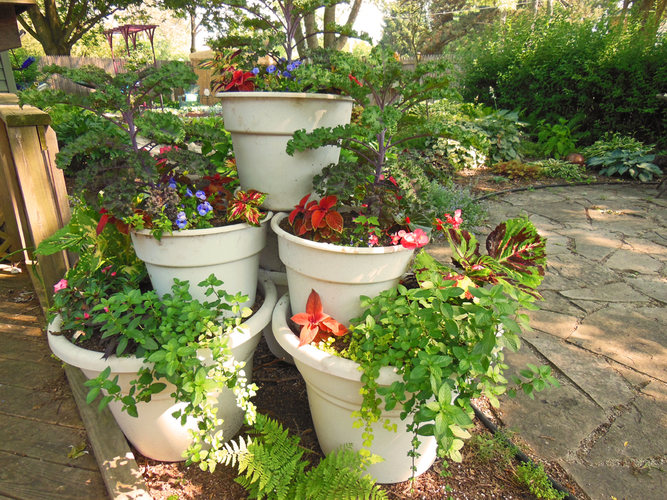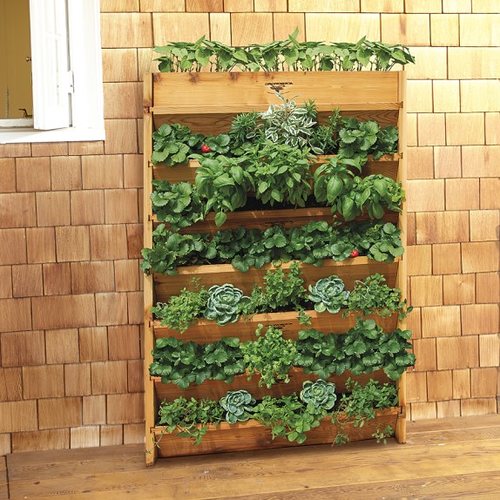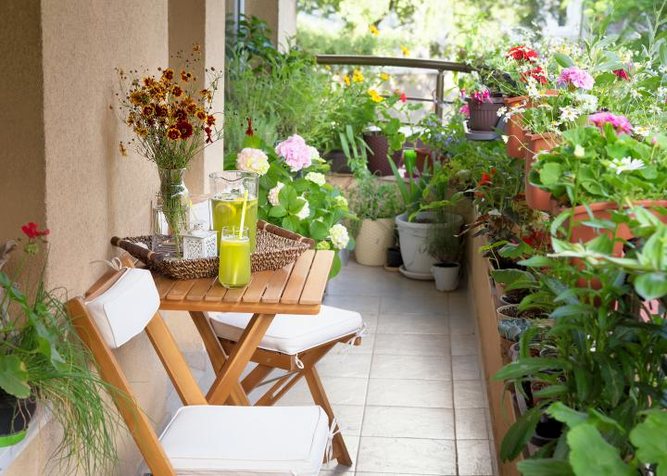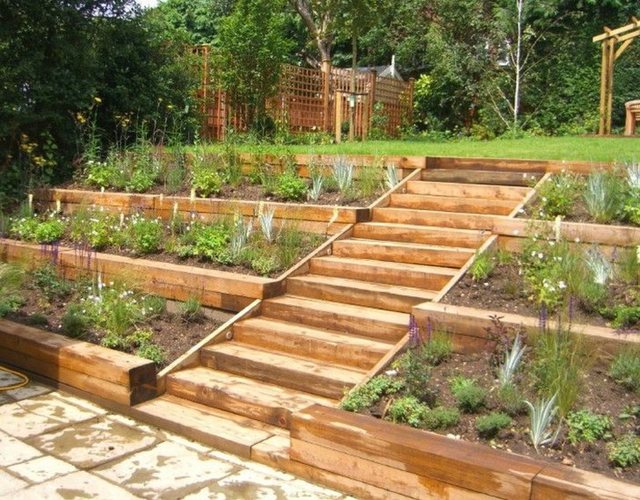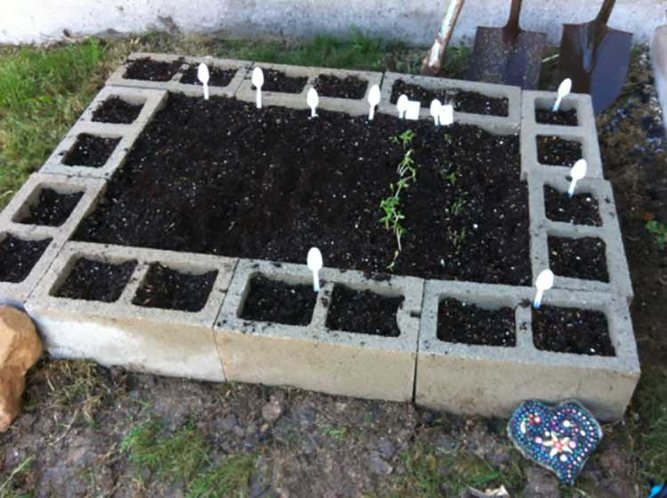By the way… any links on this page that lead to products are affiliate links and I get paid a commission if you purchase. Thanks in advance for your support.
By now, you’ve done your sun survey to find the best location for your future vegetable garden. All that’s left is to build the garden. Rather than reviewing raised garden beds benefits first, let’s talk about garden styles. Raised garden beds aren’t the only type!
Table of Contents
Garden Styles
Containers
Container gardening is lo-tech. You can use any pot or vessel of varying sizes. Containers can also go on a patio, driveway, or directly on top of a grassy plot.
Vertical Containers
Vertical containers are great options for small spaces. They are also useful if you don’t have horizontal and flat ground space. You’ll often see vertical containers on fences, walls, or on balconies.
Terraced Raised Beds
Terraced raised beds are a great option if you have sloped land. Also consider this type of garden if you don’t have horizontal, flat ground space.

Terraced Raised Beds Source
In-Ground Raised Beds
Consider this option if you have enough horizontal and flat ground space. You also need to be able to put your shovel at least 6″ into the ground. The other deciding factor in building in-ground raised beds is if your soil is safe from heavy metals. Find a local university in your area that does testing. They go for $10 and the report will let you know what’s in your soil. Here’s a test form from Virginia Tech.
Built-Up Raised Beds
Built-up raised beds look similar to in-ground raised beds. They are good if you have horizontal and flat ground space, and can dig at least 6″ into the ground. Building up above the ground is smart if you know your soil is not safe from heavy metals. If you prefer to skip the testing all together, you can’t go wrong with built-up raised beds either.
You’ll find common sizes for these to be 4 feet by 6 feet long. Most raised beds are 4 feet wide, so you can reach the center of the bed from either side without stepping into them.
We decided to go with built-up raised beds for our first vegetable garden. For the rest of this article, we’ll focus on the benefits and drawbacks of going this route.
What Are Raised Garden Beds Benefits & Drawbacks?
Benefits
- Location: Put them on concrete, grass, turf, anywhere you get 6-8 hours of sunlight
- Accessibility: Great for older people or those with mobility issues. Higher growing surface means you do not need to crouch down, reducing pain in knees or straining back.
- Soil Control: Fill with whatever soil mixture you want that will be good for your growing area
- Weed Control: Prevent weed and grass growth by adding thick pieces of cardboard at the bottom of your bed.
- Good Drainage: Soil is higher than the area surrounding it, so it will be effective at draining water out. This is especially helpful when you get a ton of rainfall in a season.
- Contained Soil: You want light, fluffy, undisturbed soil. You also want to keep your seedlings safe. Raised beds block dogs, kids, and people from stomping over your plants.
- More Food: Raised beds warm faster compared to surrounding soil, so you can plant earlier. Having a contained growing area, means more food in less space.
- They’re pretty!
Drawbacks
- More Water: May need more water since they drain well. Water evaporates faster during warmer months. Keep in mind you want to maintain water levels of 1″ of water a week or even 2″ of water during hotter months. Many will use irrigation systems to help automate watering.
- High Cost: Cost varies based on materials, raised bed size, and quantity. If you don’t already have tools to cut raw materials and connect them the way you want, this can be costly to rent or buy new.
- More Time: It takes a lot of time to decide on materials, get the materials and tools needed to build the raised beds. Then you have to consider the time to build as well.
- Wood Deterioration: If you decide to use wood, it can deteriorate over time (replace as often as every 5 years). Water moisture or heavy soil inside beds can break the structure over time.
- Bug Infestation: If you choose wood, there is a risk of termite and ant infestation.
Building VS. Buying Your Raised Garden Beds
Now you’ve decided all the benefits of raised garden beds outweigh the drawbacks. Let’s now consider whether you build or buy your raised garden bed.
Building Options
You can get creative designing something that’s ideal for your growing space. It will take some time planning, and assuming you have all the tools to build, this is a great option.
This article here has over 50+ styles, designs, and plans for building your own raised garden bed. You can get carried away ooh-ing and awe-ing at the creativity from people. It’s amazing.
There are a lot of different building materials you can use to create your raised beds. We’ll highlight some common ones below.
Wood is the most common. It’s easy to grab at your local big box store, and they’ll even cut them up for you.
You’ll want to use naturally rot-resistant and untreated wood for your raised beds. We have seen recommendations using black locust, black walnut, cypress, osage orange, red cedar, redwood, or white oak.
Iowa State University Extension and Outreach conducted a study showing wood treated with Chromated copper arsenate (CCA), Creosote, and Pentachlorophenol (or Penta). All of these chemical can leach into the soil and into your food.
CCA is arsenic leaching, Creosote is a carsenogenic, and Penta causes skin irritation. No one wants that! Takeaway here, is to use untreated wood.
Raised Beds Using Free Scrap Wood

Raised bed square foot gardening – Source
Raised Beds Using Wood Purchased From Store

Buying Wood and Building Raised Bed Source
Raised Beds Using Repurposed Cinder Blocks
The holes in the blocks act as small containers too!

Cinder Blocks Gardening Source
Buying Options
If you don’t have the time, the tools, or can’t decide on what to build, check into buying a raised bed kit. You’ll still have to decide on the material (usually wood vs metal), the size, and style, but everything comes in a box. Your job is to put it all together.
Here’s an example of a beautiful, traditional cedar raised bed you can buy.

Cedar Raised Beds Kit Source
Below is an example of a cold-rolled galvanized steel raised bed. It’s made by an Australian company called Birdies (no, not the shoe company).
We love the design, simplicity in putting the bed together, and durability of this raised bed.

Metal Raised Beds Source
FAQs for Birdies Beds
Q. What are the beds made out of and will they rust?
The 6-in-1 and Round Tall beds are made from cold-rolled galvanized steel with a metal coating composed of aluminum and zinc. It’s the same material used for roofs, gutters, and downpipes.
In a direct comparison with standard galvanized coatings, Aluzinc performs 2-6x better at rust and corrosion resistance.
With a wooden raised bed, your wood will eventually rot. Likewise, these beds will rust eventually, but it will be many, many years before this happens. We have beds still in use from 2007 that show minimal signs of corrosion, if any.
If you keep the soil free-draining, pH neutral and do not use fresh chicken manure, your Birdies beds will last you many years.
Steel: Aluzinc steel AZ150, this is widely used in Australia for Gutter, downpipes, fascia and water tanks
Galvanization: Zinc Aluminium mix.
Powder Coating Paint: The paint has been tested in accordance with AS/NZ4020. The product is categorized as nonhazardous according to the SDS.
From Epic Gardening FAQs
Here’s a video review of the Birdies beds from Self Sufficient Me. This guy is so cool, who wouldn’t trust him?
Final Thoughts
Clearly, we are in favor of the built-up raised garden beds for our first vegetable garden. While there are many things to consider like style, materials, and budget, eventually, you need to take the plunge and go for it.
We purchased four of the Birdies beds because we didn’t want to go through the process of building out our own. These metal beds seem easy to assemble, look sleek, and most importantly, they are strong! Only time will tell if they last as long as they promise.
Read my full review after using the Birdies beds.
Finally, with little kids running around our yard, we felt the Birdies beds would be safe without harsh edges.
Summary of Raised Garden Beds Benefits & Drawbacks
| Benefits | Drawbacks |
| – Location – Accessibility – Soil Control – Weed Control – Good Drainage – Contained Soil – More Food – They’re pretty! | – More Water – High Cost – More Time – Wood Deterioration – Bug Infestation |
What kind of garden do you want growing your fresh, organic vegetables for your family?
By the way… any links on this page that lead to products are affiliate links and I get paid a commission if you purchase. Thanks in advance for your support.


